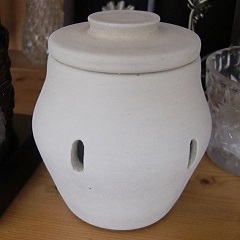PRINCIPLE
The wheel should have a max rotationspeed of some 250 r/m and my calculations prove that the steppermotor can do that. Furthermore the turn direction must be reversable. I decided to build a software that runs on an esp8266 so that most of the controls need no hardwarebuttons but only a webinterface. So we can keep the whole construction very simple. A very important principle is that the construction must be as such that no water or clay slurrie can run into the motor, this will damage it.
Materials
What we need is a stepper motor, a stepperdriver and a 60Volt dc power supply. I found a set on the internet of a nema34 stepper, a DM860 stepperdriver with a peak of 7.8A and 256 Micsteps an a 350Watt powersupply.
The disk and table
Building the disk was the first job to do. With my 3d printer i printed a mold for a flange that fits on the motorspindle and can be screwed to the disk. I mounted this mold very level on the motor and casted pu resin in it. While this was hardening i sawed a round disk out of a sheet of mdf. In the center a drilled a hole and used this to mill the disk exact circular. I milled a groove in the underside to prevent water running to the center. And some grooves on the upper side to help finding the center of the disk. Now i positioned the flange exactly in the center of the disk and marked the holes. After drilling the holes i soaked the disk with very fluide epoxy to make it water resistant.
After a successful first test i noticed that the position of a human relative to the disk is really important. The disk should be close to your lap so that you can hold your arms against your body or knees to get more stability. And you can press downwards on the clay. So i had to build a simple table. I had a sheet of MDF 18mm and bought some ikea system legs at the secondhand shop. For the dimensions a looked at some potterywheels that can be bought in the webshops.
MDF is a relatively easy to process material but vulnerable to water. Working with clay means working with water so i really have to make the MDF waterresistant. This can be done with epoxy.
THE ELECTRONICS
The microprocessor is an ESP8266-12E in my case in the guise of a Wemos that i had laying around. The mcu should provide pulses to the stepperdriver. The more pulses/sec the faster the motor runs. I used the interrupt on timer2. This works as follows:
When the timer overflows, we enter the interrupt service routine (ISR).
The ISR sets a pin high for 5 microseconds (pulsewidth)
The ISR arms the timer to decide when the next interrupt will occur.
By arming the timer with the value of a variable we can control the revolutionspeed.
Another thing to take into account is accelleration. When you provide a certain pulsefrequency to the stepperdriver, the moter runs the rpm instantly. This would swing the pot from the disk. Also stopping would cause this. So any change in rotational speed must be gradual.
CONCLUSION
Throwing a pot is something that has to be practized but the first results show that the wheel is functional. The motortorque is high enough to throw a small pot, the linits ca be tested when the table is ready. Right now i am working on the table.

